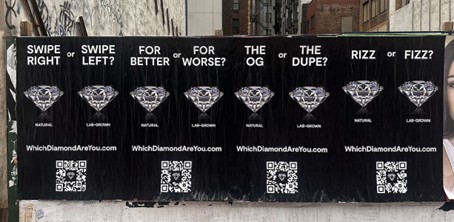In the battle for market share, the Natural Diamond Council has resorted to increasingly provocative advertising, aiming to differentiate natural diamonds from their lab-grown counterparts. One recent ad boldly proclaimed that natural diamonds have “rizz” while lab-grown stones are merely “fizz.” This kind of in-your-face marketing has sparked intense debate, with some applauding it as a necessary pushback, while others criticize it for belittling consumers’ choice of lab-grown diamonds. The question remains: can this aggressive approach win over hearts and minds, or will it alienate potential buyers in an already divided market ?
According to an oft-told tale, one night in 1947, Frances Gerety, a copywriter for ad agency N.W. Ayer, was up until 4 a.m. working on the new De Beers ad campaign. She had written all the main copy but still needed a tagline. Bleary-eyed, she cried out, “Dear God, send me a line,” then scribbled, “A diamond is forever” on a piece of paper and passed out.
Today, some people in the diamond business hope for a similar gift from the heavens as they try to revive natural diamond demand. To be clear, diamond marketing has never been easy; even during De Beers’ heyday, it had its share of clunkers. But marketing is more challenging now, considering that “natural diamonds” is essentially a new product category (as opposed to just “diamonds”).
Lab-grown diamonds have proved to be a tough, durable competitor that’s attractive to consumers. Diamond miners and dealers are clearly frustrated at losing market share to lab-growns, particularly in the engagement ring segment. Producer countries worry that their economies could be wrecked, with millions of people thrown out of work. Everyone’s scrambling for an answer.
On LinkedIn last week, Michael Schechter, vice president of digital services for Jocalio, posted a picture of four Natural Diamond Council (NDC) ads he’d seen in midtown Manhattan. One said natural diamonds had “rizz” while lab-growns were just “fizz.” Not everyone liked these Natural Diamond Council ads.

(Photo courtesy of Michael Schechter)
Schechter didn’t approve. “We are better than this as an industry,” he wrote. “There’s a healthy way to compare and differentiate these two diamonds. This isn’t it.”
His post attracted over 150 comments, most of them agreeing with Schechter. Rapaport writer Leah Meirovich agreed too, asking in a column if natural diamond advertising had “jumped the shark.”
On the other hand, diamantaire Hertz Hasenfeld, in a letter to Rapaport on behalf of the Diamond Manufacturers and Importers Association, called them much-needed.
“It’s not ‘mudslinging’ to make a clear, creative, and culturally relevant statement about why natural diamonds are unique, rare, and meaningful,” Hasenfeld wrote in the letter, shared with JCK. “The NDC and others are finally beginning to push back against a dangerous narrative. It’s long overdue.”
I understand that sentiment, but I’m not a fan of those posters. “Comparative” ads may have their place; synthetic sellers have certainly run their share. But this particular group seemed to sneer at lab-growns—a product that, like it or not, millions of consumers have chosen to buy. Their decision should be respected. And who knows? Maybe down the line, those consumers will purchase naturals. (Some consumers already buy both.) The natural industry should be trying to attract lab-grown clients, not dismissing them.
I’ve since learned those NDC ads were a low-budget “guerilla marketing” test, appearing only in New York. After the negative reaction on LinkedIn, the website they touted—whichdiamondareyou.com—was taken down.
That shows not only the influence of social media but, in a strange way, the power of physical advertising. If those ads were posted online, people may have rolled their eyes and scrolled past them. But with those ads out on the street, in view of passers-by, it felt like they have more “weight.”
The incident also illustrates the natural diamond trade’s current dilemma. It has spent the last few months debating whether to “go negative” and if it should tout gem origins. Everyone knows natural diamonds need to be reintroduced to a new generation. They just don’t agree how.
David Sherwood, CEO of Daniel’s Jewelers, believes every natural diamond should bear a distinctive visual mark. Veteran cutter Maarten de Witte posted his favored pitch on Facebook:
We do not know how natural diamonds are made. Unlike any diamond grown in a lab, natural diamonds come from places deep within the Earth that we have never visited. We know they eventually become crystalized carbon, but we don’t know if they grow from gas or liquid or solid, and we don’t have any idea how long it takes. It is a mystery. Natural diamonds are magical. They have superlative characteristics compared to all other natural gems. Maybe they are even supernatural.
Carbon is the keystone of all life on Earth. Diamond is its purest form. Let’s make that connection. To the best of our knowledge, the Earth quit making diamonds many eons ago.
READ THE ENTIRE ARTICLE HERE
(Top photo courtesy of the Natural Diamond Council)
Source : jckonline
